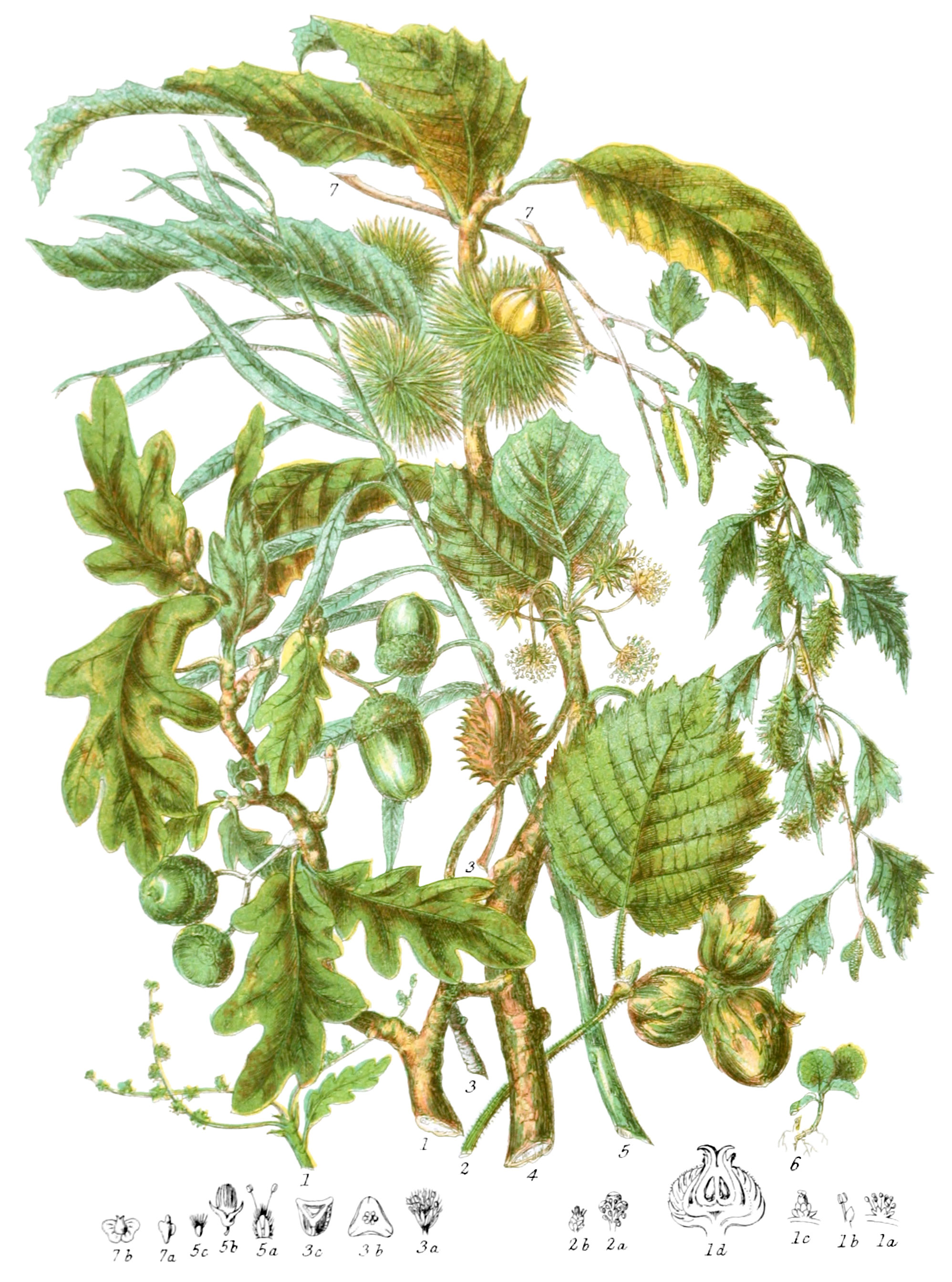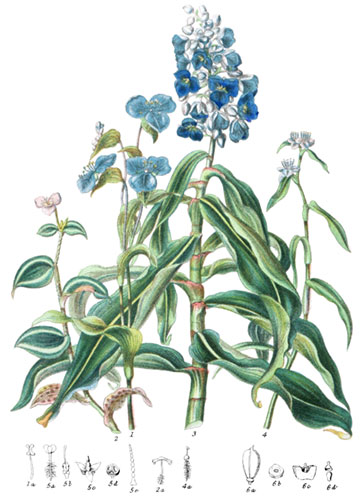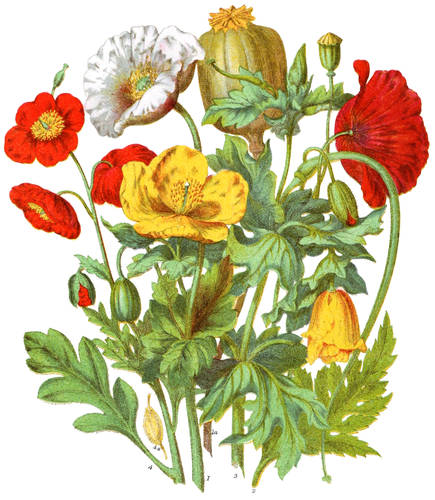Key characteristics
Trees and shrubs, the leaves are alternate, simple or lobed, the veins sometimes proceed straight from the midrib to the margin, the notched edges sometimes have glands; the stipules are either deciduous or persistent. The flowers are in catkins, and have stamens and pistil separate. The stamens vary from five to twenty, and are inserted into the base of the calyx, or scales, generally distinct, sometimes united. The anthers are two-celed. The ovary is sometimes crowned by the rudiments of the calyx, within an involucre. The fruit is a bony or leathery one-celled nut, more or less enclosed in its involcre, as in Quercus and Corylus, or it is combined with scales into a kind of cone, as in Betula, or it has many silky seeds, as in Salix. The seeds have no albumen.
This Tribe is slightly connected with Coniferaceæ.
Tonic astringent properties exist in the bark, and a balsamic oil in some species.
Select plants in this order
Not all plants listed are illustrated and not all plants illustrated are listed.
- Quercus is an important genus; Q. pedunculata (1) was formerly very abundant in England; the acorns served to feed large herds of pigs. The timber is hard and more enduring than stone in some buildings; it is also very well adapted for ships. The bark contains tannin, which renders it valuable in the preparation of leather; the galls formed on the leaves by an insect, yield a black juice, used in making ink and in dyeing.
- Q. Ilex is the evergreen oak, frequent in the south of Europe, forming part of the varied and beautiful woods on the Mediterranean coast of Italy.
- Q. suber, the cork-aok, grows lucuriantly in Portugal, affording a good supply of the useful inner bark.
- The oaks of Java have chiefly smooth-edged leaves.
- Q. angustata is found on the mountains, at 5000 feet elevation, flowering in spring, whilst the fruit of the preceding year ripens.
- Quercus ascends on the south side of the Himalayas, above 11,000 feet, but in the interior of Sikkim neither oak nor chestnut ae seen above 9000 feet.
- The N. American oaks are numerous and supply excellent timber.
- Q. coccineus, with its richly-tinted foliage, contributes largely to the brilliancy of the autumnal scene.
- On high land or near the influence of the sea oaks become stunted, and crooked branches grow within a few feet of the ground; in the woods near Cromer they are of this form, and produce no stright trunk for timber. But the most remarkable instance of deformity is the Wistman’s Wood, on Dartmoor, where the oaks are scarcely 12 feet high, the branches twisted and knotted, and covered with moss and lichen. It is said there is a record of this wood in the time of the Norman conquest.
- Corylus (2) received its specific name from Avellino, a valley in the south of Italy, where it grew in such abundance as to furnish a profitable trade in the fruit. It is very common in English copses, and is valuable for the nuts and also for the wood, which is serviceable for hoops, fishing-rods, and countless small articles.
- Fagus sylvatica (3) is of ancient fame, the nuts, called mast, being supposed to have formed part of the food of man in the earliest period. It is one of the noblest of British trees, attaining great vigour and beauty of form: the thin and supple bark is used for light boxes and baskets. Beech-woods cease above Calmar, in Sweden, at 57° north latitude; beyond that limit only single trees are seen.
- A town of Thessaly gave its name to Castanea (4); in that country, as well as on the Apennines, chestnuts prepared in different ways afford a welcome and whole some food to the peasants. The chestnut-trees on Mount Etna are of great antiquity and immense size; when old, the stems acquire vast bulk at the base, and the bark becomes twisted, giving the appearance of carved columns, as may be observed in Greenwich Park. Castanea extends northwards to the sout of Sweden.
- Salix includes many species, some affording valuable timber, others useful materials for baskets of all kinds.
- The tough pliant branches of S. viminalis (5) are available for a variety of purposes.
- S. herbacea (6), the smallest of shrubs, is one of the rare plants of the Hebrides; by the side of Alpine streams it spreads to a considerable extent, the roots penetrating the fissures of rocks.
- S. repens is of great value in the sands of Holland and Westphalia, binding the loose soil.
- S. planifolia flourishes in the cold climate of Labrador; S. serrulata is the celebrated weeping willow.
- Betula pendula (7) is the most graceul of the genus, preferring mountain localities from Lapland to Asia.
- B. alba, the common birch, is the highest of trees on the Himalaya, growing at 14,000 feet on the northern slope. In the north of Europe it is of various use, the young shoots make a kind of tea for the Finlanders; the Laplanders form tents with the supple branches; in Sweden and Norway the bark covers huts, and is ground to mix with oatmeal for cakes.
- Populus, the poplar, is dispersed in Europe and North America; the Abele and Aspen grow in moist places in England, the long leaf-stalks being compressed laterally tremble in the lightest breeze.
Locations
This exetnsive Tribe inhabits forests in all Temperate countries; it is rare in South America and the north of Africa; not known at the Cape. Fagus extends to the Antarctic regions; Betula appears on the highest mountains of Asia and America.
Legend
- Quercus pedunculata, Common Oak. Britain.
- Stamen flower.
- Stamen and Scale.
- Pistil flower.
- Section of Ovary.
- Corylus Avellana, Hazel-nut. Britain.
- Stamen flower.
- Pistil flower.
- Fagus sylvatica, Common Beech. Britain.
- Stamen flower.
- Section of Ovary.
- Section of Fruit.
- Castanea vesca, Common Chestnut. England.
- Salix viminalis, Common Osier. Britain.
- Stamen flower.
- Capsule.
- Seed.
- Salix herbacea, Least Willow. Hebrides.
- Betula pendula, Drooping Birch. Scotland.
- Calyx scale.
- Winged Seed.
Explore more
Posters
Decorate your walls with colorful detailed posters based on Elizabeth Twining’s beautiful two-volume set from 1868.
Puzzles
Challenge yourself or someone else to assemble a puzzle of all 160 botanical illustrations.





